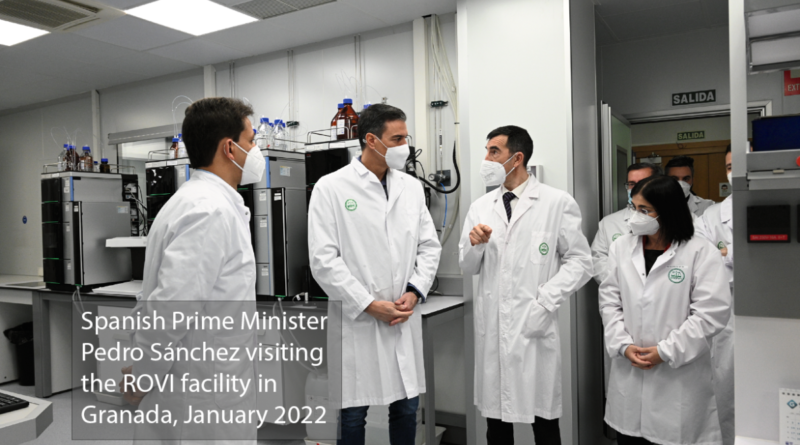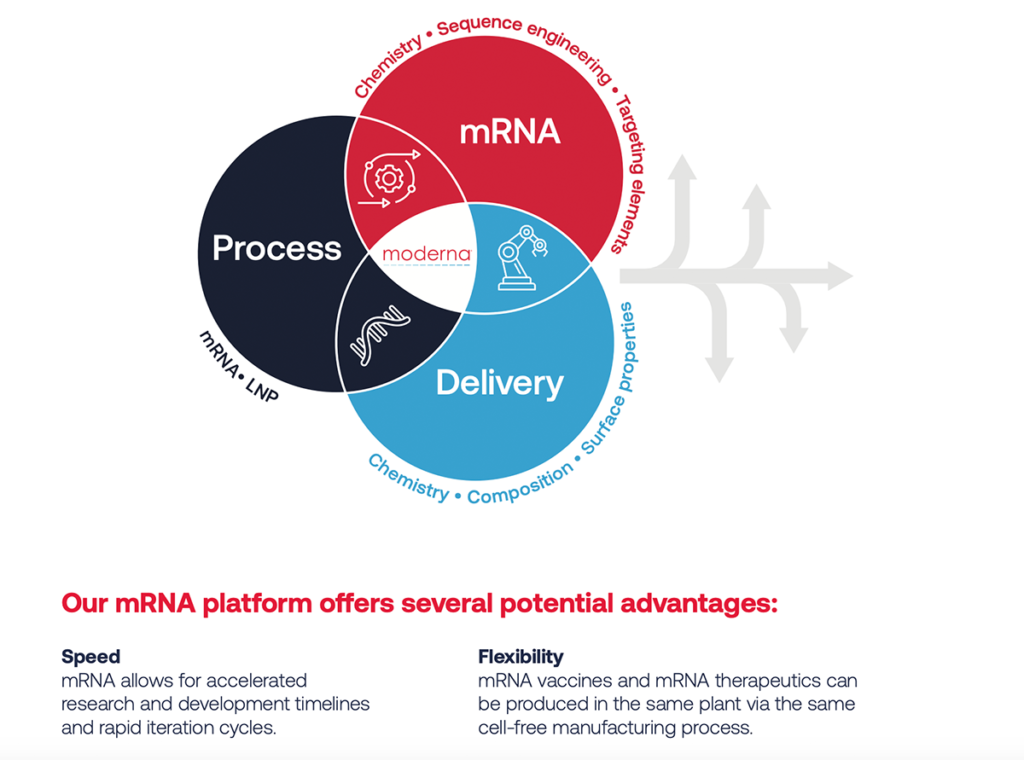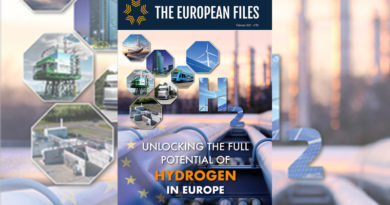
Getting the message across: A path to a healthy future for Europe
While Europe wrestles with pressing questions over its health strategy following the end of the COVID-19 public health emergency, practical answers – more than a billion of them – have been coming from a biotech that was born in the US only a decade ago. A COVID-19 vaccine that helped overcome one of the biggest health crises of modern times sprang from a pioneering approach to combating disease, coupled with the company’s agility to rapidly scale up an international manufacturing footprint.
There is the promise of more. Around a major European hub in its newly-established global network, the company is ramping up its investments in pursuit of a revolutionary vision.
Capitalising on its expertise in its own technology, it is developing products that could bring breakthroughs in the fight against infectious pathogens, cancers, rare diseases, cardiovascular disease, and much more.
This is the story so far of Moderna, the company that emerged from obscurity in the heat of the COVID-19 pandemic to become one of the world’s leading providers of vaccines. In just a few months following the emergency of the SARS-CoV-2 virus in 2020, it developed its COVID-19 vaccine – its first commercialised product. It was able to do so because of its ten years of expertise with a technology that has since acquired fame: mRNA. But great products are not enough. Memories are still sharp of the anguish with which health authorities – and patients and their families – cried out for vaccines back in early 2021 when the first supplies were being counted in trickles of mere millions. Acute health needs meant demand was high for this mould-breaking defence, and Moderna expanded manufacturing of mRNA-1273 beyond the US, widening access in Europe and elsewhere.
Achieving large-scale production for Europe against the background of urgency demanded all the responsiveness that Moderna had already shown in its short history. It requires agility to drive to reality the design and production techniques that have dramatically shortened timelines without compromising quality or safety. Light-footed and nimble, Moderna worked closely with established contract manufacturers in Spain, France and Italy and national and European regulators on the challenges of introducing its still-novel technology. Moderna had no supply chain in Europe but moved in less than a year to delivering over 800 million doses of COVID-19 vaccine by the end of 2021 – instead of the years required with traditional processes. Central to the achievement was Spain, which had no specific vaccine manufacturing plants when Moderna struck a deal with ROVI for fill-and-finish operations, in addition to signing deals with Lonza in Switzerland and ThermoFisher Scientific in Italy for drug substance and fill-finish support, respectively. ROVI operations have since matured into Moderna’s largest end-to-end production hub outside the US, producing a vaccine that has been helping to prevent severe COVID-19 disease, hospitalisation, and death in over 70 countries worldwide.
Moderna has just created a European quality testing platform in Madrid, its International Centre of Excellence, with its laboratory designed to service future products derived from the same mRNA-based technology.
The investment reflects Moderna’s engagement as Europe’s attention turns increasingly to future preparedness, in line with the European Commission’s recognition that “longer-term solutions are needed for mitigating future detrimental health events or crises.
Moderna is already using the agility of its technology to adapt its vaccines to new strains and is ensuring a capacity to respond at scale and pace to potential future disease outbreaks and pandemics. The broader risks from respiratory diseases – underlined by EU health commissioner Stella Kyriakides in the European Parliament in January – are motivating its development of vaccines against other respiratory viruses.
Investigational mono and combination vaccines against COVID-19, influenza, and respiratory syncytial virus (RSV) are in clinical development among the 47 programmes in its pipeline, 36 of which are already in clinical trials.
The same mRNA-technology is being used to develop potential vaccines against latent viruses and some of the pathogens that global warming may inflict on Europe, such as Lyme disease and malaria, and to develop treatments that offer new hope in cancer, autoimmune diseases and some of the rare conditions for which no therapies currently exist.
mRNA is the message!
Moderna was built on the guiding premise that if using mRNA as a medicine or vaccine works for one disease/pathogen, it should work for many others, potentially leading to treatments for diseases impacting millions to medicines individualised down to a single patient. Generally, the only thing that changes from one potential mRNA product to another is the instructions to produce specific proteins that solicit an immune response. This means we can use the same chemistry, formulation, and manufacturing processes across medicine portfolios, potentially increasing the probability of success from clinical trials to approval.
Moderna shares the European Commission’s view that successful health policy will depend on new approaches, and the COVID-19 pandemic has demonstrated the importance of effective collaboration among Member States, the European Parliament, the Commission, EU health authorities and “stakeholders from science, research, industry and beyond”.
But new approaches can go much further, and collaboration can go much deeper.
The supportive approach of the Spanish government and its health authorities to creating the Moderna platform has been crucial to the company’s development in Europe, as has the receptivity of the European Medicines Agency in discussions of a new category of medicines. However, the greater regulatory flexibility that the EU is now entertaining with its proposed pharmaceutical legislation reform may not be enough if the potential of technologies such as mRNA is to be realised in product innovation. Concepts that proved their worth during the pandemic in boosting speed to market and increasing flexibility in allocating product where needed most should be permanently embedded in the EU framework – rolling regulatory reviews in product authorisations, streamlined regulatory procedures, shared European packs, and electronic patient information, as well as close collaboration to facilitate distribution. This is the right moment to re-examine all the tools and mechanisms for promoting innovation: the traditional approaches may no longer be enough to ensure timely access to innovative vaccines and medicines in Europe.

The accent on prevention in the EU’s Pharmaceutical Strategy should provide a clue. Demographics-induced shifts in the population’s health status demand an adequate response by policymakers and suppliers to ensure healthy ageing. Moderna is ready to play its part – not just with new vaccines aimed particularly at adults, but in espousing a new approach to health care that could draw inspiration from the Covid experience of public-private collaboration and could generate new understanding of how best to tackle the healthcare challenges of the future.
Helpfully, the incoming Spanish presidency of the EU Council also plans to promote strategic thinking by setting as its top priority the reinforcement of Europe’s strategic autonomy. Moderna is continually maximising its own capacities for end-to-end manufacturing in the EU and elsewhere.
Still, the risks of over-reliance on remote raw materials and components suppliers have been painfully demonstrated with bottlenecks even on cardboard for packaging. At the height of the crisis, Moderna was occasionally obliged to fly individual components across the Atlantic or transport individual vaccine batches across Europe to meet emergencies.
At the company level, stronger internal integration can ease access to some critical inputs, but Europe as a whole will benefit from a deliberate build-up of independence.
As the Pharmaceutical Strategy underlines, “Investment in research and development for innovative medicines and treatments is essential for making progress in preventing and treating diseases.” Moderna agrees. Cooperation, determination and dedication among many players in the last three years provided millions with protection against the sudden emergence of a lethal infection, and Moderna is proud to have played its part. But we are only at the beginning of our story. Moderna is unique in its sole concentration on mRNA, and in its technology, its resources and its team provide the seeds to change medicines forever. Now, against the background of Europe’s recovery planning, this is an opportune time to discuss health security and pandemic preparedness. Across the many dimensions of European policy, we are looking forward to continuing to build our involvement, to more fully deploy our skills and agility, and to develop new and enduring partnerships with EU governments, authorities and stakeholders for the benefit of patients and society.





